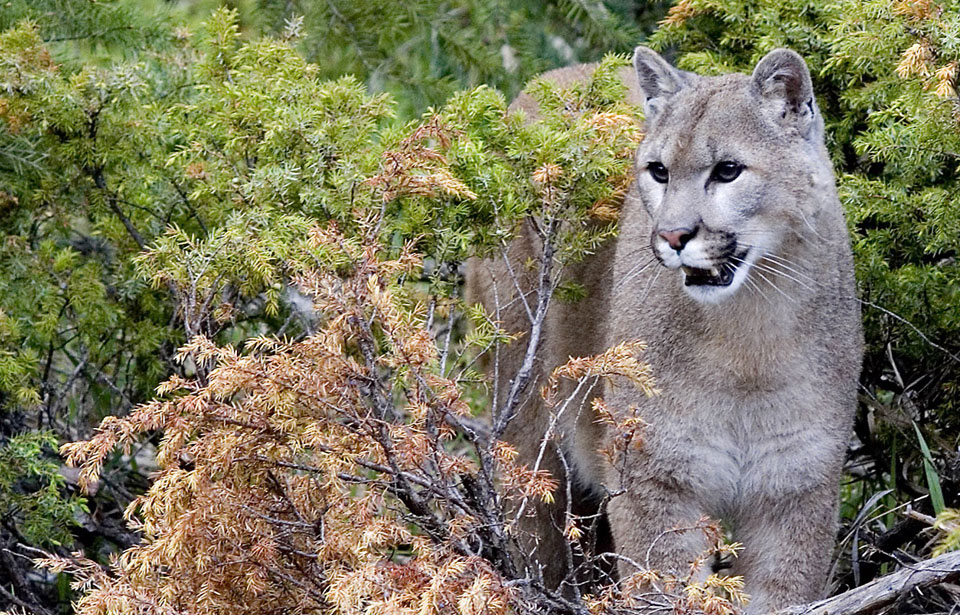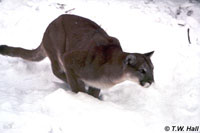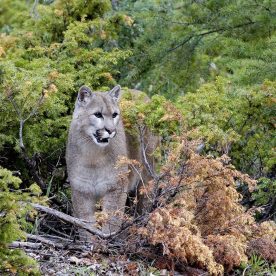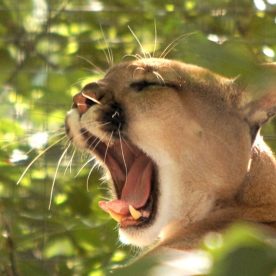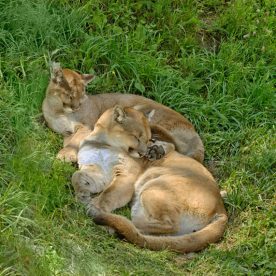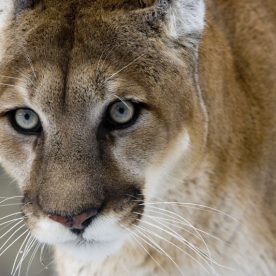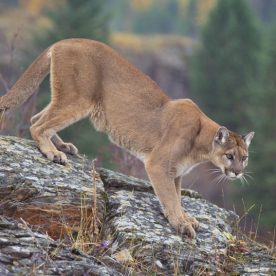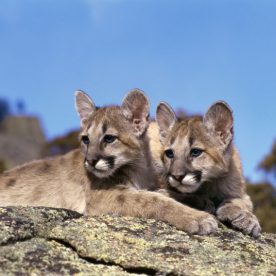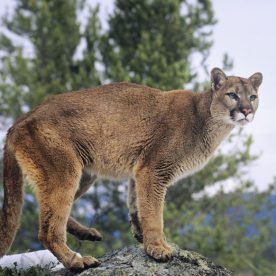Description
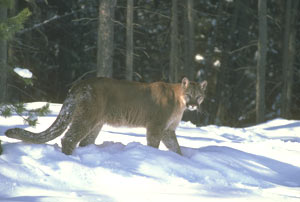 The cougar Puma concolor is one of only three wild felid species, or members of the cat family, found in Canada. Larger than the other two, the lynx and the bobcat, it is also the second largest cat in the New World. The jaguar is the largest.
The cougar Puma concolor is one of only three wild felid species, or members of the cat family, found in Canada. Larger than the other two, the lynx and the bobcat, it is also the second largest cat in the New World. The jaguar is the largest.
In the past, the North American cougar was separated into four subspecies. Recent taxonomic research suggests that all North American cougars are essentially the same species, although there are some genetic and morphological differences related to geographic location.
The cougar has a lithe, muscular, compact, and deep-chested body, with a rounded and shortened head and very visible whiskers. It has large eyes with round pupils, an adaptation to the cougar’s nocturnal, or night time, behaviour. Another distinctive characteristic of the cougar is its long tail: measuring up to a metre long, it is important for balance. It distinguishes the cougar from the lynx and the bobcat.
Cougars vary considerably in size and weight throughout their range, with individuals being larger and heavier in North America than in South America. Across the cougar’s range, adult males typically weigh almost one and a half times more than females. In southwestern Alberta, for example, average weights for adult males and females are 71 kg and 4l kg, respectively. In North America, the total body length of adult male cougars is slightly more than 2 m and of adult females, slightly less than 2 m.
Cougars in North America have short fur ranging in colour from reddish, greyish, or tawny to dark brown. The backs of the ears and the tip of the tail are black, and there are black markings on the face. Kittens are spotted at birth, but lose the spots before the end of their first year.
The cougar is well adapted for grasping and cutting up large prey, with extremely strong forequarters and neck. Its muscular jaws, wide gape, and long canine teeth are designed for clamping down and holding onto prey larger than itself, and its teeth are specially adapted for cutting meat and sinews.
Like all members of the cat family, cougars have five digits on their forepaws (including the dewclaw) and four digits on their hind paws. Each digit is equipped with a claw that remains hidden when the animal is walking but that is used with deadly effectiveness when grasping prey. The cougar’s front feet and claws are larger than its hind parts, allowing it to clutch large prey.
The cougar is known by many names, depending on local culture and legend. The Maliseet of New Brunswick call the cougar “pi-twal,” meaning “the long-tailed one.” English settlers along the Atlantic coast gave it the name “panther” after the Old World panther, which they had seen in animal shows, zoos, and artworks. The French explorers of southern Quebec and New Brunswick called it the “carcajou,” a name later given to the wolverine, causing great confusion between the two species in writings about them. The English name “cougar” and the French “couguar,” now widely used in Canada, were adapted from the Brazilian native name “cuguacuarana.” The name “mountain lion” is extensively used in the western United States, and “puma” is the native Peruvian name.
Signs and sounds
Normally a silent hunter, the cougar, like any cat, becomes vocal during the breeding season. Females in heat yowl.
Habitat and Habits
 The cougar occupies a wide range of vegetation types. It is found in habitats suitable for white-tailed deer and mule deer, the cougar’s preferred prey, and in western Canada, it inhabits forested fragments of foothills, mountains, and interior plateaus. Cover is probably the key habitat feature for a cougar since it is important for stalking prey, establishing den sites, and camouflage.
The cougar occupies a wide range of vegetation types. It is found in habitats suitable for white-tailed deer and mule deer, the cougar’s preferred prey, and in western Canada, it inhabits forested fragments of foothills, mountains, and interior plateaus. Cover is probably the key habitat feature for a cougar since it is important for stalking prey, establishing den sites, and camouflage.
Cougars live within a “home range,” where their needs for food, water, and shelter are met. Within their home range, cougars establish territories which they defend against intruders. Solitary animals, they discourage other cougars from entering their territory by leaving “scratches” or piles of leaves, pine needles, and dirt covered with urine and feces. They may also leave claw marks on trees near the edge of their territory. The scratches serve not only to delineate the boundary but also to attract females in heat. Males and females also patrol their territory.
Male cougars usually have larger home ranges than females. The sizes of home ranges vary widely, but an average male home range would cover about 300 km2, and a female’s about half that. The territory of one male rarely overlaps with another male’s territory, but it may overlap that of several females. Where home ranges do overlap, cougars still avoid each other and remain solitary, gathering only to mate.
Females are less solitary than males, remaining with their young until the kittens are about two years old. Females with large litters and juveniles, or older kittens, typically have the largest home ranges, because a large cougar family needs more food resources than a small one. In areas where prey is migratory, cougars may have more than one home range.
Cougar populations are composed of resident adults with kittens and transients. Transients most often are independent young cougars that have not yet settled on their own territory, and they tend to be male. Males typically disperse over a much greater distance than females, and are known to travel more than 1000 km from the territory where they were born.
The number of cougars in a given area, or the animals’ population density, depends on the number of available prey and suitable hunting sites. In western North America, population densities as high as four individuals per 100 km2 have been reported. Because large predators such as the cougar are at the top of the food chain, a healthy cougar population is a good indicator of a healthy ecosystem.
Unique characteristics
Cougars are extremely elusive and usually avoid direct contact with people. Masters of camouflage, they often remain hidden when approached closely on foot. While tracking a cougar during winter, a researcher stepped within 1 m of its hiding place beneath a large spruce tree before the cat bounded out of its hiding place, racing away. Tracks and tail drag marks in the snow or mud are usually the only evidence confirming the presence of these secretive, rarely seen animals.
Range
The distribution of the cougar has shrunk drastically since European settlement. In Canada, the cougar’s range once mirrored that of deer, its favourite prey, extending from the west coast south of 60° N, across the prairies, through southern Ontario’s forests to the lower Ottawa valley, the St. Lawrence valley of Quebec, and New Brunswick. Today, this large predator remains common only in the west. Nevertheless, the cougar still occupies the most extensive range of any terrestrial mammal in the western hemisphere. Its northern limit is the Yukon border at 60° N, extending south to Patagonia, Argentina. It also lives at many altitudes, from sea level to 4500 m, and in many climatic ranges, from dry deserts to deep, wet lowland tropical rainforests. Recent sightings have confirmed its presence in boreal forest habitat, where populations of white-tailed deer thrive.
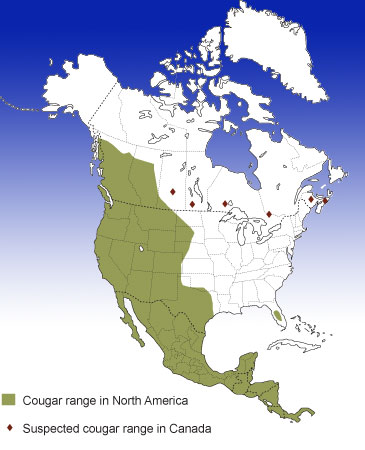
In Canada, the distribution of what was once thought to be a distinct subspecies, Felis concolor couguar Kerr, has generated much controversy. During the last century, cougars have been reported in Ontario, Quebec, New Brunswick, and Nova Scotia; in fact, more than 1000 sightings have been reported since 1949 in Nova Scotia and New Brunswick alone. However, some of the sightings have proved to be cougars from southern areas that had likely escaped or been released from captivity. There is little physical evidence, such as road kills or scats, that cougars have been present in eastern Canada since the nineteenth century.
Feeding
Cougars hunt mule deer, white-tailed deer, elk, moose calves, and in the west, bighorn sheep. As opportunistic predators, eating a wide range of available species, they may also prey on birds and other mammals, including beaver, snowshoe hare, ground squirrel, and coyote. Where a variety of prey species are available, the diet of males and females can be very different. For instance, in the Sheep River area of southwestern Alberta, moose calves account for about 85 percent of the winter prey of males, whereas deer and elk represent 79 percent of the diet of females. Cougars killed during territorial battles with other cougars may also be eaten by the successful animal. Cougars will occasionally scavenge too, meaning they will eat prey killed by other animals.
Cougars rely on sight and hearing far more than smell for hunting. They stalk their prey to within two or three great leaps and then launch a lightning-fast charge, striking their prey. Victims are most often killed by suffocation with a prolonged bite across the throat, collapsing the windpipe. The prey’s neck may also be broken with a single bite. Large prey, such as moose calves and elk, are usually suffocated, whereas small prey, such as mule deer fawns, are more likely to die from broken necks. A cougar will cover its kill with debris between feedings so as to reduce the likelihood of scavengers locating and feeding on it.
Breeding
Cougars are polygamous, which means they may have more than one mate. A male with a large home range is able to breed with many females, and a resident male usually attempts to maintain exclusive breeding rights with females within his territory. Cougars may breed any time of the year, although they most commonly breed in the winter. Males roam to breed with as many females as possible, sometimes travelling many kilometres a day searching for receptive females. Competition for female breeding rights is intense, and males are often killed in territorial fights.
Females reach sexual maturity when they are two to three years old. The gestation period lasts 90 days. They usually give birth to one to three kittens, and occasionally as many as six, but no more than three usually reach maturity. The female finds a sheltered spot such as a cave or a windfall in order to give birth. The kittens are born with their eyes closed, but they grow quickly and their eyes become fully open by the end of the second week. The female nurses the young for four to five weeks, and they remain with their mother for 18 to 24 months for food and to learn hunting skills. Females usually do not allow the male to approach the kittens as he may kill them because he does not recognize them as his own offspring. When a resident male is killed and a new male arrives in the vacant territory, he may kill all the kittens that he finds because they are not his offspring and because once the young are destroyed, the female will be more likely to breed again, producing his offspring.
The mortality rate among kittens is high during the first year and after separation from the female. As soon as the juveniles are on their own, the female is likely to breed again. In a seven-year study conducted in southwestern Alberta, females produced one litter per year.
Conservation
Humans have killed cougars throughout history because of the animals’ repeated attacks on vulnerable livestock and occasional attacks on people. Often these attacks occurred when a cougar was weakened by disease, parasites, or injury, making free-ranging or unsupervised livestock the easiest food source available. In many parts of the cougar’s historical range, humans responded to these attacks by pursuing the cougar in great “ring” hunts, in which people surrounded a large area and drove all the animals in that area into a tight circle. Predators, like the cougar, would be killed, and the other animals would be allowed to escape. Other means of eradicating cougars have ranged from hounds, traps, and poison to bounties. Cougars are also killed through trophy hunting in jurisdictions where cougar hunting with hounds is still permitted—the normally elusive cougars are easily treed by hounds. These control techniques have resulted in a drastic decline in many cougar populations.
Cougars also die following serious injuries sustained when they pursue prey larger than themselves. In addition, young usually don’t survive when a female with a litter dies, unless they are more than nine to12 months old and can feed and defend themselves. Young cougars that have recently left their mothers are also more prone to starvation than their elders. Kittens, young cougars, and adult males are sometimes killed by adult male cougars.
Originally designated “endangered” in 1978 by the Committee on the Status of Endangered Wildlife in Canada, since 1998 the cougar has been designated as “data deficient.” This status was assigned because of the lack of genetic evidence to show that the eastern race was distinct; the lack of recent physical evidence to show that cougars still occur in eastern Canada; and some information suggesting that cougar sightings may be explained by escaped captive animals. There is, therefore, insufficient information to assign a status to this animal.
Western populations of cougar appear stable, and while the cougar has virtually disappeared from eastern Canada, there are signs that it may be moving east and repopulating former ranges. In recent years, a greater presence of cougars in central and eastern Canada has been confirmed through trapping and DNA evidence. In Manitoba, one cougar was shot in 2004 and a second was discovered in a hunter’s coyote trap in 2005. These two specimens were the first to be brought to the attention of wildlife authorities in the province in 32 years. Further east, hair samples retrieved in 2000 from a car that had supposedly collided with a cougar in Quebec and DNA analysis of hair samples collected in 2003 from posts treated with cougar urine in New Brunswick have provided evidence of the cougar’s existence. With the removal of bounties and with enlightened management and conservation efforts for cougars, there is renewed hope that the species will persist throughout Canada if suitable habitat remains available.
Resources
Online Resources
Washington Department of Fish and Wildlife, Living with Wildlife, Cougars
Canadian Geographic Kids, The Cougar
Printed Resources
Banfield, A.W.F. 1974. The mammals of Canada. University of Toronto Press, Toronto.
Culver, M., W. E. Johnson, J. Secon-Slattery, and S. J. O’Brien. 2000. Genomic ancestry of the American puma (Puma concolor). The American Genetic Association 91: 186–197.
Nowell, K., and P. Jackson. 1996. Wild cats—status survey and conservation action plan. IUCN/SSC Cat Specialist Group, Gland, Switzerland.
Parker, G.R. 1998. The eastern panther. Nimbus Publishing, Halifax.
Ross, P. I., M. G. Jalkotzy, and M. Festa-Bianchet. 1997. Cougar predation on bighorn sheep in southwestern Alberta during winter. Canadian Journal of Zoology 74: 771–775.
Scott, Fred. 1998. COSEWIC status report on cougar, eastern population, Puma concolor couguar. Committee on the Status of Endangered Wildlife in Canada, Ottawa.
Stocek, R.F. 1995. The cougar, Felis concolor, in the Maritime Provinces. Canadian Field-Naturalist 109: 19–22.
Wissink, R. 2005. Back from the brink? The eastern cougar lives! N.B. Naturalist 1(4): 109.
© Her Majesty the Queen in Right of Canada, represented by the Minister of Environment, 1973, 1984, 1988, 1990, 2008. All rights reserved.
Print version
Catalogue number CW69-4/26-2006E
ISBN 0-662-44614-3
Online in HTML and PDF at www.hww.ca.
PDF version
Catalogue number CW69-4/26-2006E-PDF
ISBN 978-0-662-47058-8
Text: B.S. Wright
Revision: Associated Resource Consultants Ltd., 1990; Diane L. Amirault-Langlais, 2007.
Photo: COREL Corporation
Illustration: B.S. Wright



